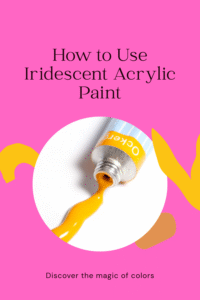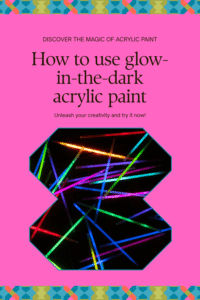When it comes to painting projects, choosing the right type of paint can make all the difference. Whether you’re customizing your favorite T-shirt or creating a stunning mural, the type of paint you use plays a crucial role in the outcome of your work.
For many crafters, fabric paint and acrylic paint are two popular choices but what’s the difference? And which one should you choose for your project?
In this blog post, we’ll dive deep into the world of fabric paint and acrylic paint, comparing their properties, uses, and more. By the end, you’ll have a clear understanding of which paint is best suited for your next masterpiece.
Fabric Paint vs Acrylic Paint: What’s the Difference?
When we talk about paint for creative projects, the first thing that comes to mind is often acrylic paint. After all, acrylics are versatile, widely available, and great for a range of mediums. But when it comes to fabric painting, fabric paint seems to be a more popular option. So, what’s the difference?
Fabric Paint: The Flexible Choice
Fabric paint is specifically designed for use on fabric. It is formulated to stay flexible after it dries, ensuring that your painted designs won’t crack or peel as the fabric moves and stretches. Fabric paint also has a smoother texture, which makes it easier to apply onto fabric without soaking it.
The primary benefit of fabric paint is its long-lasting ability to adhere to textiles without damaging the material. It’s available in various finishes like matte, gloss, or metallic, making it perfect for customized clothing, home décor, and accessories.
Acrylic Paint: The All-Purpose Powerhouse
Acrylic paint is known for its versatility and quick-drying nature. It can be used on almost any surface—wood, canvas, metal, plastic, and yes, even fabric though it’s not specifically made for fabrics.
Acrylic paint dries into a hard, durable finish, which makes it more prone to cracking or peeling on fabric unless you take extra steps to make it more flexible.
While acrylic paint offers more color intensity and versatility (you can mix it with a wide variety of mediums), it’s not ideal for fabrics unless you add special fabric medium to the paint. Fabric mediums help to make acrylic paint more suitable for textiles, improving its flexibility and adhesion.
The Main Differences between Fabric Paint and Acrylic Paint
To make your decision easier, let’s break down the key differences between fabric paint and acrylic paint:
| Aspect | Fabric Paint | Acrylic Paint |
| Composition | Water-based with fabric-specific additives | Water-based with a polymer binder |
| Texture | Smooth and soft | Thicker and sometimes more textured |
| Finish Options | Matte, gloss, metallic | Matte, gloss, satin, and more |
| Flexibility | Stays flexible, doesn’t crack on fabric | Hard finish, may crack unless a fabric medium is added |
| Durability | Long-lasting on fabric | May peel or crack on fabric without a medium |
| Drying Time | Dries quickly, but can be slower than acrylic | Dries quickly, typically in 15-30 minutes |
| Best Use | Clothing, home décor, fabric accessories | Can be used on canvas, wood, and fabric (with a medium) |
| Special Features | Designed to remain on fabrics and flex with wear | Suitable for many surfaces, including fabric with added medium |
When to Use Fabric Paint
So, when should you reach for fabric paint instead of acrylic paint? Here are some scenarios where fabric paint is your best option:
1. Customizing Clothes or Textiles
Fabric paint is ideal for clothing, bags, hats, and other fabric-based items. The flexible nature of fabric paint means your designs will bend and stretch with the material, avoiding cracks and peeling as you move or wash the fabric.
2. Creating Detailed Fabric Art
If you’re working on a fabric project like quilting or textile art, fabric paint is a great choice. It’s designed to flow smoothly across the fabric, making it easy to apply intricate designs and patterns.
3. Designing Home Décor
If you’re painting items like throw pillows, curtains, or tablecloths, fabric paint will ensure the paint stays intact and doesn’t damage the fabric’s texture or appearance.
When to Use Acrylic Paint
Acrylic paint is a wonderful medium for many types of artwork, and here are some situations where it works well:
1. General Crafting and Mixed-Media Projects
Acrylics are ideal when you’re working with mixed media or projects that require heavy layering and texturing. Their fast-drying nature allows you to build up multiple layers of paint without a long wait time.
2. Painting on Surfaces Other Than Fabric
Acrylics excel on canvas, wood, ceramics, and other non-fabric surfaces. Their versatility makes them a favorite for artists who enjoy experimenting with different mediums.
3. When Using a Fabric Medium
If you already have acrylic paint and want to use it on fabric, you can mix it with a fabric medium. The fabric medium will add the necessary flexibility to the acrylic paint and make it more suitable for fabric.
Step-by-Step Guide to Using Fabric Paint
Materials you’ll Need:
- Fabric paint (matte, gloss, or metallic)
- Paintbrushes or sponge brushes
- Protective sheet (to place under fabric)
- Stencils or masking tape (optional)
- Fabric medium (if you’re using acrylic paint)
- A piece of cloth or fabric to paint on
Instructions:
- Prepare Your Workspace
Lay down a protective sheet or newspaper to avoid mess. Make sure the fabric you’re using is clean and free of wrinkles. - Choose Your Design
Sketch your design on paper, then transfer it to the fabric using a fabric-safe pencil or chalk. Alternatively, you can use stencils for a precise design. - Start Painting
Using your paintbrush or sponge brush, begin applying the fabric paint in light layers. Allow each layer to dry before adding another to avoid smudging. - Let It Dry
Fabric paint dries relatively quickly, but make sure to let your project dry completely before moving or using it. - Set the Paint
Some fabric paints require you to heat-set the paint by ironing it (with a cloth over the design). Follow the paint’s instructions for setting.
Step-by-Step Guide to Using Acrylic Paint on Fabric
- Prepare the Fabric
Wash and dry the fabric to remove any dirt, oils, or sizing. Iron the fabric if necessary. - Mix with Fabric Medium
If you’re using acrylic paint, mix it with fabric medium in the ratio recommended by the manufacturer. - Apply the Paint
Apply the paint just like fabric paint, working in light layers. If you want, you can also add texture using a sponge or palette knife. - Dry and Heat-Set
Let the paint dry completely, then heat-set it according to the fabric medium’s instructions.
Common Mistakes to Avoid
1. Not Prepping the Fabric Properly
If you skip washing and prepping your fabric, the paint may not adhere properly. Always ensure your fabric is clean and dry before you start painting.
2. Not Using the Right Paint for the Right Project
Using acrylic paint on fabric without a fabric medium can lead to cracking. Likewise, fabric paint may not provide the same intensity of color on non-fabric surfaces as acrylic paint.
3. Rushing the Drying Process
Acrylics dry quickly, but fabric paint may require more time. Be patient and give your project enough time to dry completely to avoid smudging or mistakes.
4. Not Setting the Paint
If you don’t heat-set your painted fabric, the paint may wash off over time. Make sure you follow the manufacturer’s instructions for setting the paint.
Conclusion: Fabric Paint vs Acrylic Paint – Which One Should You Choose?
In the end, the choice between fabric paint and acrylic paint comes down to the project at hand. If you’re working on a fabric surface and need a paint that flexes with the material, fabric paint is your go-to option. On the other hand, if you’re after vibrant colors and versatility across various mediums, acrylic paint (with a fabric medium) could be the way to go.
Key Takeaways:
- Fabric paint is specifically designed for fabric and remains flexible.
- Acrylic paint can be used on fabric but requires the addition of a fabric medium.
- Fabric paint is ideal for custom clothing, textile art, and home décor.
- Acrylic paint excels in versatility and works well on multiple surfaces, including fabric (with fabric medium).
No matter which paint you choose, remember to prep your materials properly and follow the instructions for the best results. Happy painting!
FAQs
1. Can I use acrylic paint on fabric without a fabric medium?
It’s not recommended. Acrylic paint can crack and peel on fabric if not mixed with a fabric medium to improve its flexibility.
2. What is the best fabric paint for clothing?
Some of the most popular fabric paint brands include Tulip, Martha Stewart, and FolkArt, known for their vibrant colors and durability on fabric.
3. How do I prevent fabric paint from cracking?
Make sure to apply thin layers of paint, avoid overloading your brush, and always allow proper drying time. Additionally, heat-setting your painted fabric helps improve its longevity.
4. Is it okay to wash fabric painted items?
Yes, but you should follow the care instructions for your fabric paint, which often include washing the item inside out in cold water to preserve the design.



